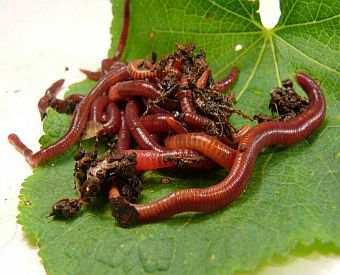The 25-Second Trick For Red Wiggler Express
The 25-Second Trick For Red Wiggler Express
Blog Article
Top Guidelines Of Red Wiggler Express
Table of ContentsThe smart Trick of Red Wiggler Express That Nobody is Talking AboutThe Ultimate Guide To Red Wiggler ExpressAbout Red Wiggler ExpressExamine This Report about Red Wiggler ExpressSome Known Incorrect Statements About Red Wiggler Express Get This Report on Red Wiggler Express
Like all worms red worms take a breath oxygen through their skin. A wet atmosphere additionally helps with the breakdown of natural issue in their bed linen product by microbial life forms.
During mating worms slide along each other up until their clitellum are straightened. They hang on per various other with bristle like hairs, called setae, situated on their bottom. While welcomed they exchange reproductive seminal fluids which is saved for later usage. Throughout the breeding session, which lasts for about 3 hours, the worms secrete mucus rings around themselves.
See This Report on Red Wiggler Express
Before going down off all the required reproductive materials are scooped up right into the ring. When the mucous ring leaves the worm the end seals up, creating it to taper at one end, triggering the familiar lemon form of the cocoon (Red Wigglers For Sale). Over the following 20 days the cocoon dims and hardens
Some worm farmers really keep food and water to simulate dry spell problems and bump up cocoon production. We do not recommend this for the home composter as it has the potential to exterminate a lot of of your ideal worms. Since you recognize everything about the red worm it's time to go out and discover a good provider and obtain a pound or 2 and begin your very own worm farm.

Indicators on Red Wiggler Express You Need To Know
The digestive system is easy, starting at the mouth where the worm starts to consume its food prior to passing it on to the pharynx. The throat is a muscle section which imitates a pump to pull food into the mouth before pumping it out into the esophagus. The esophagus is narrow and thin-walled and functions as the "waiting area" for the gizzard.
Keep in mind: This demand for grinding is why grit is advised in a worm container. The worm features no native grinding capability so the worm counts on ingested grit to help grind its food in the gizzard. The tummy is where the first chemical break down of food occurs with the assistance of a protein-busting enzyme.
The intestinal tract forms the longest part of the worm and is where the bulk of food digestion takes place using enymatic processes. The spreadings eventually pass via the rectum at the end of the worm as capsules coated with a biologically-rich mucous.
Unknown Facts About Red Wiggler Express
Within 42 days, these infant worms will reach sex-related maturation as shown by the introduction of the clitellum. A mature red wiggler can be expected to live between one to three years. The magnificent red wiggler might occasionally be utilized as a lure worm for smaller sized fish or as a healthy protein resource for hens and reptiles.

And as mentioned over, they are one of the most common composting worm in the world. Why? Well there's probably not simply one factor. Rather, a mix of price, hardiness, and convenience in a wide variety of temperature levels makes it one of the most proper composting worm for a lot of new vermicomposters. Red wigglers and their cocoons can survive in a variety of conditions.
This is a common practice among worm shippers that don't desire to run the risk of having the worms sit in a warm or cold warehouse over the weekend break. Worm growers are not saving worms in a situation where they are ready to deliver. The worms should be collected from their habitat initially, so growers will certainly frequently establish a Friday or Saturday deadline in order to harvest in time for a Monday shipment.
The Buzz on Red Wiggler Express
To save on delivery expense, you might want to see if there are any kind of neighboring "Mama and Pop" shops via a Google search.
I call these the "Large 3" aspects of worm container upkeep. As pointed out earlier, red wigglers have a broad temperature tolerance.
A lot of worm bin owners run their worm bins means as well damp. And a properly-maintained worm bin should not be producing leachate.
For ideal outcomes, you want to shoot for about 60-70% dampness level. At the best wetness degrees which is just under 70% that handful need to barely yield one decline of liquid.
How Red Wiggler Express can Save You Time, Stress, and Money.
The European Nightcrawler, the bigger cousin of the red wiggler, is equally as voracious and additionally creates an excellent lure worm - Worm Farms United States. It favors a little bit of a cooler environment than the red wiggler. The African Nightcrawler is a huge composting worm and makes a lovely, granular actors
(https://greenydirectory.com/gosearch.php?q=Red+Wiggler+Express)The Indian Blue is ravenous, however also chooses a warmer climate and it likewise displays a propensity to escape the container. The red wiggler is a hardy worm and isn't as fussy about its environment. I like to call it the Ford Taurus of vermicomposting worms; you won't brag to your hardcore composting pals that you have them, yet they will certainly serve you well.
Surefire active 1/2 lb of hand arranged Red Wigglers/Compost with worms (+500 worms) in various stages of life from cocoons to grow worms in their natural environment/bedding. Hand sorted worms reduced down on the disruption of the worms thus insuring online shipment. Red wiggler worms do not like vibrations or light.
Report this page